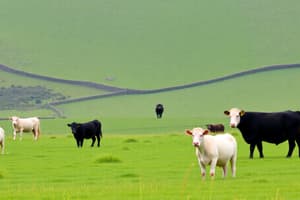Podcast
Questions and Answers
What is the primary objective of liming and reseeding in rough mountain/hill grazing?
What is the primary objective of liming and reseeding in rough mountain/hill grazing?
- To enhance soil fertility and structure (correct)
- To improve grass palatability
- To promote grass growth in the reproductive phase
- To increase livestock units
Which of the following grazing methods involves dividing a large area into smaller sections?
Which of the following grazing methods involves dividing a large area into smaller sections?
- Paddock Grazing (correct)
- Mixed Grazing
- Strip Grazing
- Block Grazing
What is the primary factor affecting silage production quality?
What is the primary factor affecting silage production quality?
- pH level
- Dry Matter percentage
- Dry Matter Digestibility percentage
- All of the above (correct)
What is the benefit of wilting in the silage production process?
What is the benefit of wilting in the silage production process?
Which of the following grass types is suitable for leys?
Which of the following grass types is suitable for leys?
What is the measurement of grazing needs, equivalent to 12 tonnes of herbage annually?
What is the measurement of grazing needs, equivalent to 12 tonnes of herbage annually?
What is the primary phase of grass growth where tillers form?
What is the primary phase of grass growth where tillers form?
What is the primary factor affecting palatability in grass?
What is the primary factor affecting palatability in grass?
Which of the following grass types is suitable for mixed grazing?
Which of the following grass types is suitable for mixed grazing?
What is the primary purpose of dry matter intake in grazing management?
What is the primary purpose of dry matter intake in grazing management?
What is the primary purpose of hay production in grazing management?
What is the primary purpose of hay production in grazing management?
What is the primary stage of silage production where the grass is cut?
What is the primary stage of silage production where the grass is cut?
Flashcards are hidden until you start studying
Study Notes
Types of Grazing
- Rough mountain/hill grazing involves permanent grassland on peaty, difficult-to-cultivate soil, which can be improved by liming and reseeding.
- Leys are temporary grasslands with variable botanical composition, medium stocking rates, and production levels.
Grass Growth Phases
- Vegetative phase: tillers form
- Elongation phase: stem growth occurs
- Reproductive phase: seed head emerges, and growth slows down
Grass Quality
- Palatability: measures the taste of grass, affecting grazing preference and intake
- Productivity: measures the quantity of herbage produced, with higher productivity providing more available for grazing
- Digestibility: proportion of food assimilated vs. consumed, crucial for livestock nutrition
- Dry Matter (DM): remaining matter after water removal, impacting nutritional value
- Dry Matter Digestibility (DMD): percentage of dry matter digested by animals
- Dry Matter Intake (DMI): amount of feed consumed excluding water content
Seed Selection
- Options include Perennial RyeGrass, Italian RyeGrass, White Clover, and Red Clover for different grazing needs
Grazing Methods
- Paddock Grazing
- Strip Grazing
- Block Grazing
- Zero Grazing
- Creep Grazing
- Mixed Grazing
- Extended Grazing
Livestock Units
- 1 Livestock Unit (LU) = 12 tonnes of herbage annually, used to measure grazing needs
Silage and Hay Production
- Silage production: fermentation of grass for preservation, affected by factors like pH, DM%, and DMD%
- Hay production: dehydration of grass for preservation, inhibiting microbial activity
Silage Production Steps
- Field preparation
- Cutting at the vegetative stage
- Wilting
- Chopping
- Compacting
- Covering with polythene
Types of Grazing
- Rough mountain/hill grazing involves permanent grassland on peaty, difficult-to-cultivate soil, which can be improved by liming and reseeding.
- Leys are temporary grasslands with variable botanical composition, medium stocking rates, and production levels.
Grass Growth Phases
- Vegetative phase: tillers form
- Elongation phase: stem growth occurs
- Reproductive phase: seed head emerges, and growth slows down
Grass Quality
- Palatability: measures the taste of grass, affecting grazing preference and intake
- Productivity: measures the quantity of herbage produced, with higher productivity providing more available for grazing
- Digestibility: proportion of food assimilated vs. consumed, crucial for livestock nutrition
- Dry Matter (DM): remaining matter after water removal, impacting nutritional value
- Dry Matter Digestibility (DMD): percentage of dry matter digested by animals
- Dry Matter Intake (DMI): amount of feed consumed excluding water content
Seed Selection
- Options include Perennial RyeGrass, Italian RyeGrass, White Clover, and Red Clover for different grazing needs
Grazing Methods
- Paddock Grazing
- Strip Grazing
- Block Grazing
- Zero Grazing
- Creep Grazing
- Mixed Grazing
- Extended Grazing
Livestock Units
- 1 Livestock Unit (LU) = 12 tonnes of herbage annually, used to measure grazing needs
Silage and Hay Production
- Silage production: fermentation of grass for preservation, affected by factors like pH, DM%, and DMD%
- Hay production: dehydration of grass for preservation, inhibiting microbial activity
Silage Production Steps
- Field preparation
- Cutting at the vegetative stage
- Wilting
- Chopping
- Compacting
- Covering with polythene
Studying That Suits You
Use AI to generate personalized quizzes and flashcards to suit your learning preferences.




